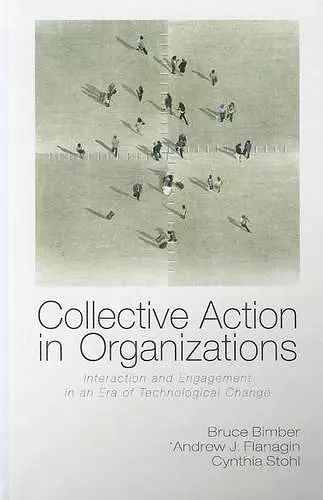Collective Action in Organizations
Interaction and Engagement in an Era of Technological Change
Bruce Bimber author Andrew Flanagin author Cynthia Stohl author
Format:Hardback
Publisher:Cambridge University Press
Published:29th Feb '12
Currently unavailable, and unfortunately no date known when it will be back
This hardback is available in another edition too:
- Paperback£23.99(9780521139632)

Explores how people participate in public life through organizations. The authors examine three organizations and show surprising similarities across them.
This book explores how people participate in public life through organizations in a time when digital media can make organizations seem irrelevant. The authors examine three of the largest organizations in the United States. In each, people use technology when they participate, but technology does not make them participate more.Challenging the notion that digital media render traditional, formal organizations irrelevant, this book offers a new theory of collective action and organizing. Based on extensive surveys and interviews with members of three influential and distinctive organizations in the United States - The American Legion, AARP and MoveOn - the authors reconceptualize collective action as a phenomenon in which technology enhances people's ability to cross boundaries in order to interact with one another and engage with organizations. By developing a theory of Collective Action Space, Bimber, Flanagin and Stohl explore how people's attitudes, behaviors, motivations, goals and digital media use are related to their organizational involvement. They find that using technology does not necessarily make people more likely to act collectively, but contributes to a diversity of 'participatory styles', which hinge on people's interaction with one another and the extent to which they shape organizational agendas. In the digital media age, organizations do not simply recruit people into roles, they provide contexts in which people are able to construct their own collective experiences.
“Theories of collective action traditionally focus on the central role of organizations in overcoming the high cost of individual participation. In turn, new information and communication technologies and their ability to lower the costs of participation have been seen as sounding the death knell for such organizations. Starting instead from the perceptions, attitudes and actions of organizational members themselves, Bimber, Flanagin, and Stohl argue that individuals’ ‘participatory styles’ interact with organizational structures and the new information environment to create a complex “collective action space.” The result is not the death of formal organizations but a shift in power and agency from leaders to members. Collective Action in Organizations is a major contribution to both our empirical understanding of and our theorizing about civic and political engagement in the new information age.” —Michael X. Delli Carpini, Dean, Annenberg School for Communication, University of Pennsylvania
“This book ushers in a new era of theorizing on collective action. It turns both and contemporary notions of collective action on its head. First, this book brings the individual - and individual differences - back into traditional collective action by theorizing that people’s contributions are shaped not just by demographics or an economically driven cost-benefit calculus but more substantially by their interaction and engagement. Second, the book brings the relevance of the formal organization back into contemporary notions of collective action. Using compelling evidence, the authors argue that the advent of digital media enables formal organizations to offer much broader opportunities for people to define themselves and to establish their own participatory styles. By bringing to the fore both the individual and the formal organization, the authors offer a timely, balanced, and intellectually engaging corrective to previous under-socialized and over-socialized views of collective action.” —Noshir Contractor, Jane S. & William J. White Professor of Behavioral Sciences, Northwestern University
“Collective Action in Organizations poses a fascinating theoretical and practical question: ‘How do people experience collective action within formal organizations in the contemporary media environment?’ Part of the answer that Bimber, Flanagin, and Stohl provide lies in the dynamic, ubiquitous communication context in which human organizing and collective action now occurs, one which provides people with an unprecedented array of low-cost, easy-to-use communication tools that facilitate collective organizing. The other part lies in a reconceptualization of collective action space. In support of their theory the authors report the results of a major NSF-supported research program in three major organizations: The American Legion, AARP, and Move On. This is a terrific book. It combines solid, new theorizing with crisp, well-executed data analysis. And, the results are surprising! Whether your interests lie in communication technologies, social movements, formal organizations, or some combination of the three, you will find Collective Action in Organizations a thought-provoking and idea-generating experience.” —Peter Monge, University of Southern California
“Collective Action in Organizations offers a pathbreaking analysis of the role of new communication technologies in collective action. Its nuanced analysis reconceptualizes civic participation in terms of multiple levels of engagement and interaction afforded by various modes of communication, from face-to-face interaction to newly-minted social networking technologies. Bimber, Flanagin, and Stohl offer a theoretically sophisticated and empirically supported framework that reaffirms the importance of organizations in what appears to be the increasingly fragmented and individualized world of online participation, protest, and politics. Their model and research shows the multiple ways in which citizens connect with civic organizations and how communication technologies figure in this process. It picks up where Putnam’s Bowling Alone leaves off, revealing some surprising new wrinkles and dynamics that Putnam and his successors have not fully considered. This engaging book makes us rethink the role of new communication technologies in politics, public life, and in the lives of citizen participants.” —Marshall Scott Poole, Professor of Communication and Director of the Institute for Computing in the Humanities, Arts, and Social Science, University of Illinois Urbana-Champaign
ISBN: 9780521191722
Dimensions: 235mm x 158mm x 15mm
Weight: 450g
240 pages